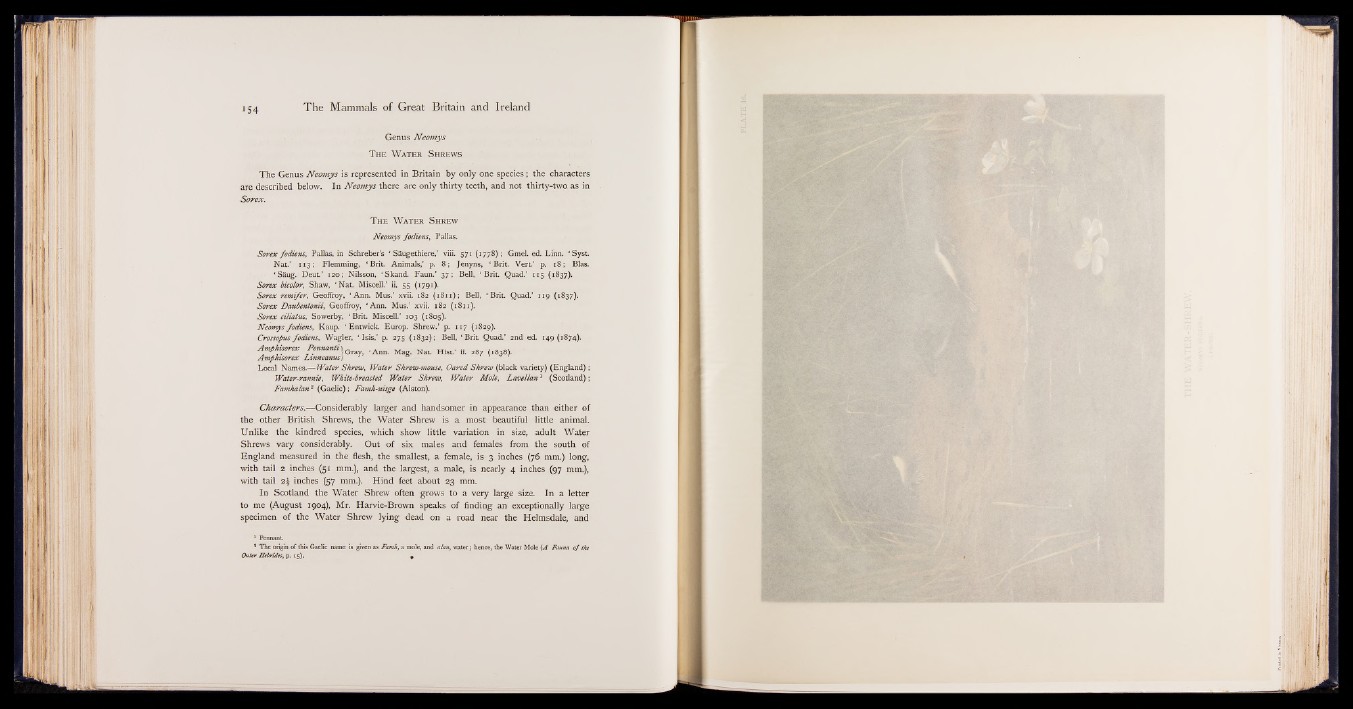
Genus Neomys
T h e W a t e r S h r e w s
The Genus Neomys is represented in Britain by only one species; the characters
are described below. In Neomys there are only thirty teeth, and not thirty-two as in
Sorex.
T h e W a t e r S h r e w
Neomys fodiens, Pallas.
Sorex fodiens, Pallas, in Schreber’s ' Saugethiere,’ viii. 571 (1778); Gmel. ed. Linn. ‘ Syst.
Nat.’ 1 13 ; Flemming, ‘ Brit. Animals,’ p. 8 ; Jenyns, ‘ Brit. Vert.’ p. 18; Bias.
‘ Saug. D eu t’ 120; Nilsson, ‘ Skand. Faun.’ 37; Bell, ‘ Brit. Quad.’ 115 (1837).
Sorex bicolor, Shaw, ‘ N a t Miscell.’ ii. 55 (179.1).
Sorex remifer, Geoffroy, ‘ Ann. Mus.’ xvii. 182 (181 1); Bell, ‘ Brit. Quad.’ 119 (1837).
Sorex Daubentonii, Geoffroy, ‘ Ann. Mus.’ xvii. 182 (1811).
Sorex ciliatus, Sowerby, ‘ Brit. Miscell.’ 103 (1805).
Neomys fodiens, Kaup. ‘ Entwick. Europ. Shrew.’ p. 117 (1829).
Crossopus fodiens, Wagler, ‘ Isis,’ p. 275 (1832); Bell, ‘ Brit. Quad.’ 2nd ed. 149 (1874).
Am fhisorex P enm n ii1 ,Ann. M Nat. ■ 1 287 (.838).
Amphisorex LtnneanusJ
Local Names.— Water Shrew, Water Shrew-mouse, Oared Shrew (black variety) (England);
Water-rannie, White-breasted Water Shrew, Water Mole, Lavellan1 (Scotland);
Famhalan2 (Gaelic); Famk-uisge (Alston).
Characters.— Considerably larger and handsomer in appearance than either of
the other British Shrews, the Water Shrew is a most beautiful little animal.
Unlike the kindred species, which show little variation in size, adult Water
Shrews vary considerably. Out of six males and females from the south of
England measured in the flesh, the smallest, a female, is 3 inches (76 mm.) long,
with tail 2 inches (51 mm.), and the largest, a male, is nearly 4 inches (97 mm.),
with tail inches (57 mm.). Hind feet about 23 mm.
In Scotland the Water Shrew often grows to a very large size. In a letter
to me (August 1904), Mr. Harvie-Brown speaks of finding an exceptionally large
specimen of the Water Shrew lying dead on a road near the Helmsdale, and 1
1 Pennant
* The origin of this Gaelic name is given as Famh, a mole, and alan, water; hence, the Water Mole (A Fauna o f the
Outer Hebrides, p. 15). ,